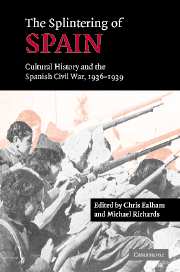Book contents
- Frontmatter
- Contents
- List of illustrations
- List of maps
- List of contributors
- Preface
- List of abbreviations
- Chronology
- Maps showing the division of Spain, 1936-1939
- 1 History, memory and the Spanish civil war: recent perspectives
- Part I Overviews: violence, nationalism and religion
- Part II Republican political and cultural projects
- Part III Identities on the Francoist side
- 8 Old symbols, new meanings: mobilising the rebellion in the summer of 1936
- 9 ‘Spain's Vendée’: Carlist identity in Navarre as a mobilising model
- 10 ‘Presenting arms to the Blessed Sacrament’: civil war and Semana Santa in the city of Málaga, 1936–1939
- Notes
- Index
9 - ‘Spain's Vendée’: Carlist identity in Navarre as a mobilising model
Published online by Cambridge University Press: 28 July 2009
- Frontmatter
- Contents
- List of illustrations
- List of maps
- List of contributors
- Preface
- List of abbreviations
- Chronology
- Maps showing the division of Spain, 1936-1939
- 1 History, memory and the Spanish civil war: recent perspectives
- Part I Overviews: violence, nationalism and religion
- Part II Republican political and cultural projects
- Part III Identities on the Francoist side
- 8 Old symbols, new meanings: mobilising the rebellion in the summer of 1936
- 9 ‘Spain's Vendée’: Carlist identity in Navarre as a mobilising model
- 10 ‘Presenting arms to the Blessed Sacrament’: civil war and Semana Santa in the city of Málaga, 1936–1939
- Notes
- Index
Summary
A readiness to pass judgement on the adversary became a key element in the deployment of propaganda in the Spanish civil war. With respect to Navarre, this was made clear by Arthur Koestler in 1937: ‘The Pyrenean valleys of Navarre had remained a stronghold of medieval tradition; it was Spain's Vendée and the birthplace of the Carlist movement.’ The French counter-revolutionary rising of 1793, became a mythical point of reference for all those subsequently in active opposition to revolutionary processes. The Vendée was an ideological point of contact for diverse movements characterised by religious, traditionalist, anti-modern, rural, dynastic and localist claims. It is not surprising, therefore, that the Vendée should serve as a historical marker for Koestler through which he sought to find an explanation for the 1936 events in Spain.
In 1936 the image of Navarre had long been associated with the particular political, social and ideological views which constitute the Carlist variant of traditionalism. The role of Navarre during the civil war was to become decisive, resulting in a reconfiguration of the rules of Carlism's self-understanding as the movement's elites searched for a definition more in accordance with the new situation.
Navarre was an essentially agricultural region (agricultural labourers accounted for 61 per cent of the workforce in 1930), with a pronounced religious tradition. In the north and centre of Navarre, there was a relatively egalitarian model of property distribution and, although the more unbalanced pattern of land ownership in the south provoked social conflict during the first part of the twentieth century, overall there was little tradition of class-based trade unionism before the Republic, the labour movement being dominated by Catholic unions.
- Type
- Chapter
- Information
- The Splintering of SpainCultural History and the Spanish Civil War, 1936–1939, pp. 177 - 195Publisher: Cambridge University PressPrint publication year: 2005
- 1
- Cited by



